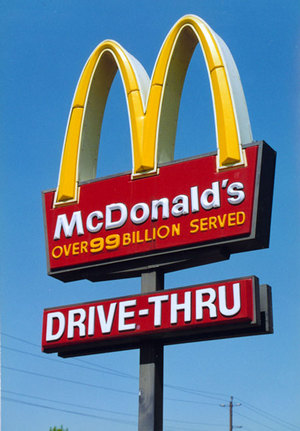Interstate Drive Thru

Drive to virtually any American fast food establishment and you likely have the option to place your order and receive your food without ever leaving your car. Typically, the drive-thru experience involves a hard-to-understand speaker surrounded by a large glowing menu, shouting your order into a microphone, driving up a bit further to a window through which an employee hands you your order and you hand back the cash. The entire process takes only a few minutes, but some view using the drive-thru — especially for fast food — as laziness, even going so far as to suggest taxing it. After all, the person taking your order is only a few steps away.
Maybe.
Drive-thru fast food is serious business — with serious money involved. While each individual item may cost only a few dollars, the National Restaurant Association (per MSNBC) estimates that the fast food industry grossed $168 billion in the U.S. in 2011, and 70% of that came in through the drive-thru window. So it only makes sense that these companies experiment with potential optimizations. One such idea? In late 2004, McDonald’s began implementing a centralized call-center in Santa Maria, California, a three hour drive from Los Angeles, which handled drive-thru orders placed around the country, even in Hawaii. So while you, the Chicken McNugget-ordering customer, think you are speaking to someone in the building right next to you, the person asking if you want fries with that may in fact be hundreds if not thousands of miles away.
In 2006, the New York Times chronicled the experience of one such call-center worker. Some early results suggest that the centralized call centers, while problematic at times (such as when local dialects make orders difficult to understand), can shave seconds off of each transaction. And when processing in excess of one order per minute at peak times, such improvements are significant. Since the Times story, other companies have experimented with centralized call centers as well; according to a 2010 article in the Roanoke Times, both Wendy’s and Pizza Hut have used the system. (Strangely, in the aforementioned Times article, a Wendy’s exec is quoted, saying that the organization wasn’t yet ready to try call centers — they hadn’t given it “any serious thought.”)
Not all fast food joints have employed the system, though. In MSNBC article linked above (and for ease of navigating, here — it’s worth reading the whole thing) discusses, in depth, Taco Bell’s attempts to improve their drive-thru order fulfillment process. Not only does Taco Bell not have centralized call centers, but the author pans the process as “yesterday’s big idea.”
Bonus fact: Taco Bell’s menu purports to be some variety of Mexican food, but don’t tell that to people actually living in Mexico — they probably won’t believe you. The company launched its first Mexican restaurant in 1992, but as another MSNBC article notes, within two years, all of them had gone out of business. The company (or, more accurately, its parent company, YUM! Foods) tried to re-enter Mexico, calling their offering “American” food, but those stores went under by 2010.
From the Archives: McHotdogs: You can get a fried fish sandwich at McDonalds, but you probably can’t get a hot dog. Here’s why.
Related: A 6″ plush Taco Bell dog.
